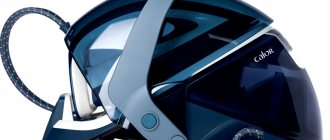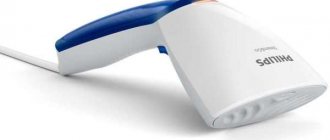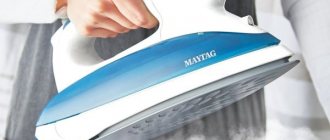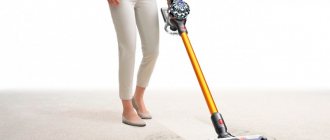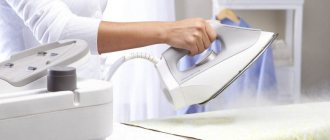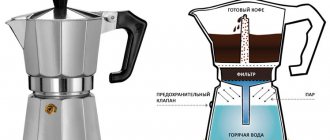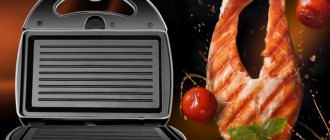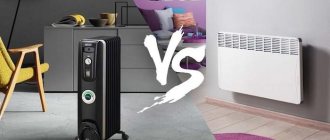What is a steamer?
The simplest and most inexpensive steamer looks more like a kettle than an iron. It consists of a water tank, a heating element and a head through which the generated steam is released.
The main feature of the steamer is that it smoothes things in a vertical position without contacting the fabric.
The following types of steamers are distinguished:
- Manual. A compact device that fits comfortably in your hand. Consists of a handle, a heater and a water tank. They can easily steam curtains, T-shirts before going out, dresses, and small items.
- Vertical. It looks like a trempel with a water tank. A steam pipe and a nozzle for steam release extend from the tank. On average, the volume of the water tank is 1 liter, and the length of the tube is 1 m. It is distinguished by high power. You can steam a lot of clothes with it, as well as clean upholstered furniture, pillows and curtains.
Typically, the devices supply wet steam. It turns out that the fabric becomes somewhat moisturized when smoothed. It is necessary to ensure the purity of the water used so that no stains remain. In addition, the clothes may remain damp for some time (usually 10-20 minutes).
Dry steam steamers are considered the most modern.
The steam in them is heated twice, so there is practically no moisture at the outlet. Dry steam is supplied at high speed and under high pressure, and its temperature reaches 100 degrees.
Features of the steamer
Vertical and manual steamers are available for sale, smoothing fabrics with a stream of hot air.
The vertical one consists of a water tank (large enough), a telescopic rack for clothes, a flexible hose and a nozzle. When turned on, the water in the boiler boils, steam enters the hose and is discharged out through the holes in the nozzle.
In a handheld steamer, the water container is built into the body and there is no steam hose, so the device looks more compact. But its tank capacity is usually small.
The steamer processes clothes with wet steam and without pressure on the fabric - unlike a steam generator.
Wrinkles are eliminated due to wetting of the fibers, and the steam supply force here is less than that of a steam generator. The device irons thick, multi-layer teak, cotton and linen poorly, but is ideal for light, delicate fabrics.
The steamer is used for vertical processing of clothing, disinfection and neutralization of odors, cleaning curtains, upholstered furniture and carpets, washing windows and tiles.
Advantages and disadvantages
The steamer produces hot steam continuously but naturally. The weaker the vaporization, the longer it will take to add water to the tank, but the efficiency will be lower.
Regardless of the modification, the device has many advantages:
- heating rate;
- maneuverability;
- no mechanical pressure on the tissue;
- removal of surface contaminants;
- disinfection;
- different modes.
The main disadvantages of any steamer (although, rather, features) are operation only in a vertical position and the relatively low temperature of the steam at the outlet. You cannot completely replace an iron with it, because it will not iron a pleated skirt or create creases on trousers if the package does not include the appropriate attachment.
What is a steam generator?
Steam generators are irons with an improved steam function.
You should not compare them with models that came before - with a weak “zilch” and an insignificant effect of smoothing the fabric. Steam generators are powerful, characterized by an abundant steam cloud that works even at a distance.
The device consists of a regular iron, which is connected by a thick tube to a station consisting of a water tank and a steam converter. The steam is supplied through the tube to the soleplate of the iron and exits through small holes to the outside.
In steam generators, you can regulate the steam supply:
- turn off steam;
- use steam constantly;
- use a steam "blow".
In the latter case, steam flies out under pressure, penetrating deep into the fabric and instantly smoothing it. In parallel with this, you can use a metal sole by selecting the desired temperature.
Steam generators convert water into steam heated to 130-160 degrees. At this temperature it acquires the properties of dry. Things are not moistened and are thoroughly disinfected from germs and dust mites.
Features of steam generators
Steam generator Tefal GV5245
There are irons with advanced steam processing capabilities. These capabilities are made possible thanks to the steam generator used in conjunction with the iron. Therefore, today an iron with a steam generator is simply called a steam generator. However, such a device differs from a regular iron. Simple irons have a “boost of steam” function that releases a strong stream of steam. But for a steam generator this is the most common operating mode. Moreover, such devices have large water tanks, which ensures fairly long operation. That is, the steam generator can work for 30 minutes, and sometimes longer.
The steam generator is specifically for ironing things. It looks like a simple iron connected by a tube to a plastic box. This box contains, you guessed it, a water tank.
What is the difference between them?
Research conducted by the Swiss laboratories Scitec Research SA has shown that Laurastar dry steam kills 99.9% of bacteria and viruses and completely destroys dust mites. Thus, steaming not only improves the appearance of things, but also allows for disinfection.
We recommend: Which TV to choose: LG or Samsung, comparison of main characteristics
Steam treatment allows you to smooth out wrinkles on delicate fabrics, refresh clothes and remove foreign odors.
Both a steam generator and a steamer do an excellent job of this. But there is a significant difference between them:
- The steam generator combines the functions of a steamer and an iron; the steamer only affects things with steam (not counting steam stations with a metal iron).
- The steam generator requires an ironing board. Additional accessories are not required for the steamer.
- The steam generator must be held horizontally. Use a steamer to “iron” things only vertically, otherwise water may leak out.
The main difference between a steam generator and a steamer is the principle of smoothing the fabric. When using an iron, the fabric is flattened due to direct contact with the hot soleplate. Steam in this case only enhances the effect. The steamer smoothes out wrinkles using steam, and only steam. Its effect is more gentle, does not damage the fibers and does not create a shiny effect.
What is the difference: the main differences between the two devices
Both devices are designed for ironing textiles. They easily handle all types of fabrics, smooth and renew the appearance of clothes, curtains, tablecloths and bedspreads. In addition, they can be used for deep cleaning of dirt and dust from all types of surfaces.
In this case,
the following main differences can be identified.
The steamer acts on the object using wet steam, and the steam generator delivers a powerful jet of dry steam under pressure; this device works on the principle of thermal shock.- The temperature of the steam created by the steamer is no more than 100°C; the steam generator emits jets of steam with temperatures up to 160°C, so its effect on the surface is stronger.
- The steam generator is a more powerful device; it is able to quickly smooth out multi-layered and thick fabrics, with complex folds and decorative elements.
At the same time, the high temperature of exposure guarantees additional disinfection of all processed items and removal of various contaminants.A steamer acts more gently on the surface; this device does not make it possible to cope with large volumes of clothes and other things that need ironing in a short period of time.
- The steamer is equipped with a small container for water; it is lighter and more transportable, but during long-term operation it requires periodic filling of the container with a new portion of liquid. The steam generator has a large container for liquid, so it can operate for a longer period without additional refilling.
In order for the steamer to start working, it takes no more than 1 minute after turning it on; a household steam generator will require 7-9 minutes.
comparison table
To clearly determine what is more convenient to use in everyday life, you need to understand how often you have to iron your clothes, and what kind. Comparing a clothes steamer and a steam generator in the table will help you make your choice:
| Steamer | Steam generator | |
| Purpose | Smoothing clothes with steam | Ironing and steaming clothes and home textiles |
| Water consumption | 80-120 ml/min | 20-55 ml/min |
| Steam | Dry or wet (for inexpensive models), temperature about 100 degrees | Always dry, temperature 130-160 degrees |
| Ready for work (steaming) | 30-40 seconds after switching on | 8-10 minutes after switching on |
| Steam position | Vertical | Horizontal |
| Maneuverability | High, especially for manual models | Bad |
| Smoothing delicate fabrics | Yes | Yes |
| Smoothing thick fabrics | Average | Yes |
| Smoothing clothes with complex elements | Yes | Average |
| Can be used for cleaning | Yes | No |
| Price | 2800 rub. on average for hand steamers, and 7,000 rubles. for vertical | 4000-16000 rub. |
Pros and cons of a steamer
First of all, steamers are valued for their compactness, portability and gentle effect on fabrics. The products cannot be “scorched”, “burned” or damaged in any way. Such devices are often used in clothing stores, where there is no time to bother with ironing on an ironing board. But the device has both pros and cons.
For convenience, we consider them in the table:
| Steamer | |
| pros | Minuses |
| There are inexpensive models, costing from 1500 rubles | Not all models iron clothes equally well, especially multi-layered ones made from thick fabrics |
| You don't need an ironing board to iron things | After treatment with wet steam, things need to dry |
| The vertical design allows you to process upholstered furniture, hanging curtains, soft toys | |
| Things look voluminous, you can easily smooth out complex elements | |
| The fabric fibers are not compressed and steam does not damage them. As a result, products last longer | |
| The steamer is easy to clean fur coats, outerwear | |
Advice. To smooth thick fabric with a steamer, you need to stretch it. A heat-protective glove should be used when working.
Advantages and disadvantages
To better understand how these devices differ, you should study in detail the advantages and disadvantages of each device.
Steam generator
The advantages of the steam generator include the following features of this device :
generates a powerful jet of dry steam at high temperature, which makes it possible not only to iron and disinfect the surface of any type of fabric, but also to remove various dirt and stains;- has high productivity , which allows the housewife to cope with a large volume of work in a short time, quickly and efficiently smooth out complex surfaces, draw arrows, smooth out pleated products;
- multifunctionality : modern models are complemented by a large set of different attachments that allow you not only to iron, but also to clean the apartment, clean any surfaces, care for furniture, curtains, your own car, clean the homes of pets and much more;
- has a large water container, so it does not require frequent refilling;
- complemented by a control panel that allows you to regulate the pressure and temperature of the steam supply;
- has an “anti-drip” system , which ensures automatic shutdown if liquid gets on the inner surface of the iron sole.
The disadvantages of this device include:
- bulk and heaviness;
- high cost;
- rapid formation of scale on the walls of the container and hose, which requires additional effort to clean them, but more expensive models have a self-cleaning function from scale.
Steamer
The advantages of this device include:
maneuverability and ease of transportation, which allows you to take this device on the road and easily use it outside the home if necessary;- takes up little space;
- the presence of a telescopic pipe or a lightweight manual model allows you to easily and quickly process the product by weight;
- consumption of a small amount of energy;
- relatively inexpensive cost;
- versatility, the device copes not only with ironing, but also with cleaning, and is capable of removing simple stains from clothes and other surfaces;
- works with wet steam, which allows you to give the product a renewed appearance and eliminates foreign odors from the item.
The disadvantages include:
- low productivity in comparison with a steam generator, the speed of processing products with a steamer is much lower;
- low power of the steam jet, so it is more suitable for working with delicate fabrics; it is not always able to smooth out harder surfaces with large creases and complex folds;
- the relatively low temperature of the steam does not provide reliable disinfection of the surface.
Pros and cons of a steam generator
Steam generators have become widespread due to their advantages over conventional irons.
Let's look at their pros and cons in the table:
| Steam generator | |
| pros | Minuses |
| Completely replaces the iron | It is difficult to steam bulky items made from delicate fabrics (inconvenient to use vertically) |
| Quickly smoothes out wrinkles and severe creases | Ironing board required |
| Bed linen can be ironed even when folded. Steam penetrates 4-8 layers of fabric | |
| The steam function allows you to disinfect even delicate fabrics | |
| You can use only an iron or only a steamer, or you can combine two functions | |
We recommend: Durable granite or “living” marble – which is better and more expensive, more durable and better for a monument
Which is better to choose?
Steamers are less popular than classic irons and steam generators. Most housewives are more familiar with them, and therefore more convenient to use.
For the average family, it is better to choose a steam generator. It is an excellent replacement for an iron; it allows you to steam and iron things.
In what cases should you take a closer look at a steamer:
- If you often need to iron things with a complex cut, thin fabrics, or many decorative elements.
- When the apartment is critically short of space, and there is no way to place an ironing board in it.
- For a single man or teenager who finds it difficult to master the intricacies of ironing.
What to choose for your home?
The steam generator is the most powerful and versatile device that effectively and quickly copes with ironing and cleaning. But it is more expensive, consumes more energy, and is less maneuverable.
This device is suitable for solving large-scale problems related to:
ironing large amounts of clothing;- cleaning difficult stains on furniture and curtains;
- cleaning kitchen surfaces;
- removing greasy stains and deposits on kitchen tiles;
- sanitization of pet cages;
- cleaning hard-to-reach places using special attachments;
- cleaning the car interior;
- processing pillows, blankets and upholstered furniture.
If the housewife is faced with less voluminous tasks and she needs a maneuverable, convenient device for daily use, as an assistant in everyday cleaning or ironing, then a steamer will be the best option.
The steamer is convenient to store or transport. It starts working almost immediately after switching on, so it can easily and quickly handle small amounts of work and make the housewife’s daily work easier.
If you need an assistant, primarily in ironing, then the best choice would be a household steam generator, which will allow you to iron and clean clothes at the level of dry cleaners from any type of fabric. This is a professional device that can provide high quality ironing in record time.
Reviews
The devices receive different reviews. Much depends on the functionality of the model and the assigned tasks. Reviews allow you to understand why the steam generator and steamer are used:
Varvara:
“I bought a hand-held steamer for my daughter’s stage costumes. The main thing is to get used to the principle of steam supply. It comes in portions. You need to press the button every few seconds. Smoothes fabrics well. I even ironed my husband’s shirts a couple of times.”
Konstantin:
“I haven’t used an iron for 5 years. Steamer only. It takes up little space and irons things perfectly. No scorches or creases. But you have to wait until it warms up, otherwise it will splash water.”
Faith:
“My mother-in-law gave me a cheap hand-held steamer. For the needs of a family of 4 people, this is a toy. I persuaded my husband to buy a steam generator. Now I'm enjoying it. In seconds, it smooths out T-shirts, shirts, blouses, trousers, towels, and folded bed linen. Without any effort or inconvenience. I use one ironing mode – the minimum is enough to solve all problems.”
What are the differences between the devices
Before talking about the differences between the devices, it is worth talking about their general advantages. Firstly, you don't need an ironing board to use them. Secondly, they do not take up much space when folded, and thirdly, they are very easy to use. In addition, both the steam generator and the steamer are universal devices that can be used for ironing clothes, bed linen, home textiles, upholstery, etc.
But as mentioned earlier, these are not the same household appliance. Both devices work by exposing the fabric to a stream of hot air and are designed for ironing textile surfaces. The main differences between the two devices are the method of steam supply and the principle of operation.
Garment steamer
How the steamer works
Most devices are gravity-fed, that is, hot air is supplied continuously from the tank. Modern models are equipped with many operating modes, but the principle of steam generation is the same for all types of devices.
It is as follows:
- water is poured into a tank, where it is brought to a boil by heating;
- evaporation in the form of a stream of hot air continuously rises up the hose;
- The wet steam is discharged out through the nozzle, thereby smoothing the fabric.
The differences include the presence of a rack with a clothes hanger. Ironing is carried out in a vertical position due to steam, which is supplied in the direction of movement of the nozzle. The kit may include a surface that makes horizontal ironing possible, but not all models are equipped with this component.
The steamer is designed for vertical ironing
The principle of operation of the steam generator
These devices have many modifications. There are models in which the nozzle is made in the form of an iron, which is capable of smoothing fabric in both vertical and horizontal positions. There are devices with narrow, cone-shaped and elongated nozzles, but the same removable components may be included in the set of standard models.
The operating principle is as follows:
- water is poured into the tank and brought to a boil;
- steam under pressure is supplied to the hose, from where it is discharged through the nozzle to the outside with sharp emissions.
The main difference between a steam station and a steamer is that it creates dry steam rather than wet steam. Its temperature is higher, so it smoothes the fabric faster and more efficiently.
One of the types of steam generator
